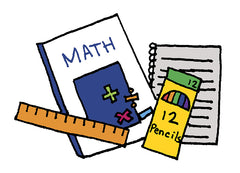It's a fair and common question: "How am I going to teach all my children at different levels at the same time?" Don't worry; it really is doable!
First, have you seen the articles floating around about how much time a child actually needs to spend sitting and concentrating? A kindergartener, for instance, is expected to spend 30-90 minutes a day at traditional schoolwork in this distance learning world, with only 3-5 minutes at a time of sustained attention. (The whole chart is below.)
This confirms what many of us have experienced. A great day of homeschooling does not need to include hours and hours of sitting at a table working furiously through worksheets! So what does a great day look like at our house?
1. Routine
You don't need a detailed schedule. Not all of us operate well with a mandate that math must happen from 9:05 AM until 9:22 AM! Instead, try a gentle routine. E.g., breakfast, morning chores, school time, read-alouds, then outdoor time. This gives you the framework to know what is happening next, without the stress of having a hungry newborn or vigorous breakfast discussion "mess up" the whole day.
See this post for a glimpse into our current daily routine with twin kindergartners and a preschooler.
2. Scaffolding to Independent Learning
As teachers, we need all of our students to be able to do some work independently. For our little ones, this can be as simple as Mad Mattr or playdough, while our bigger kids will do more and more on their own.
Of course, if your child is not reading yet, you will be doing all the direction-giving for them. And, regardless of reading level, all children will hit activities that stump them and will come to you for coaching. That's entirely appropriate!
Your goal is to give them the tools to do more and more on their own. So for the littlest ones, it can be as simple as asking them to put in one puzzle piece before they get down from the table. Next week you can ask them to do two or three, and so on until you can set a puzzle in front of your little one and have him put it together while you work on today's math with the big kids.
Teaching independent learning is like building a muscle. Regardless of the age and skill level of your child right now, you can build on it until you get where you want to be. For an older child, it would be appropriate to set this as a goal together. "This year, you are old enough to manage a lot of your work yourself, so I will be helping you learn how to do that."
3. Combine Subjects as Desired
If you have children who are close in age, it can make a ton of sense to all learn the same history, science, or even STEM together. Our team will be happy to make specific recommendations if that helps. Just let us know the grade levels of your children, along with whether you are looking for classic or nonreligious options. If your youngest tends to love listening in on big brother's science already, or all three students have advanced fine motor skills, that information is helpful for us as well! We won't always have ideas (it's challenging to chart a course that includes both toddlers and teens!), but we love to help and will eagerly pass along any insights our team can come up with here! (Email mail@timberdoodle.com or chat us from the green box in the lower right of your screen.)
4. Stay Flexible
We really can't stress this enough. If your first-grader needs more one-on-one help this morning than you anticipated, perhaps your older students could save their questions for later and work on the pages they know how to do. If you are going to be driving a lot today, grab your Story of the World CDs and listen as you go, even if it isn't your normal history day.
Timberdoodle kits are set up with a weekly checklist to make this as easy as possible. Do science on Monday or Saturday - it won't matter! Do a little bit of written work each day or pack most of the worksheets into the first two days of the week to maximize the weather… you get to pick. Find a rhythm that works for you and settle in, but know that a little swap won't mess you up for the rest of the week!
If you're not quite ready for the freedom of a weekly schedule, we also have a daily option included. Just tweak it until it's perfect for you, then print!
Tips for young students
For your younger learners, you want to keep lessons fast-paced and varied. Your new preschooler may be ready to add a few raindrops to his drawing page, then move on to Plus-Plus Big. A few minutes later, have him do a page or two in Mathematical Reasoning, followed by a few more raindrops on the earlier drawing page, then ending by pouring water with his science beakers. You want to stop each subject while he's still enjoying it, and slowly build up his endurance levels without making it tedious. We're not talking about having him sit at the table filling in tedious worksheets for an hour; we're talking about a fast-paced array of activities that he looks forward to each day.
Even kindergartners and first-graders will benefit from mixing it up. Did he just finish a worksheet? Why not swap to STEM? Is he most focused right after playtime? Let's tackle math or language arts then.
The other component to keep in mind is your child's sensory needs. Take frequent breaks to go swing or jump, allow him to work standing instead of sitting, give him a fidget, pass out gum… Each child's sensory needs can be so very different, but take the time to figure out what helps your child focus and use that!
Special notes for teens
We always say that particularly in the teen years, you'll go from teacher to coach. You want your child to have a lot of input into what the end goal is, and both be on the same page as to how you'll get there. Obviously, you are still the parent and responsible for the end results, but your year will go so much more smoothly if you and your child agree early on how you're going to reach his destination.
Does your child have a career in mind? (Yes, homemaking is totally a career!) Or general interests he wants to pursue? If he's narrowing down options, have him think through how he'd like to position himself to live, serve, give, and play. If he dreams of being an inner-city pediatrician who is raising a large family while volunteering in orphanages three times a year and owning a private yacht, he's going to want to get a realistic grasp on those costs! The dreaming stage is a pretty fun project for most teens, so if you have a child who doesn't know where to start, it may be helpful to assign him a new idea every month:
- Computer tech working locally, two children, renting a home next door
- PUD employee, single, buying a home across the country.
- Lawyer in the closest big city, six children, buying a home near the courthouse
- Single foster parent, working from home, owns his own home in an area where the need is greatest.
Feel free to use his interests and aptitudes to build his list and make sure he uses real-world examples. (For instance, local real estate listings, cost of living estimates, job openings, etc.)
Once he has an idea of his direction, set a course. (He can change courses as needed, but there's no need to drift!) Work with him to research his next steps. If he's college-bound, what do his dream colleges want to see on his application? Or if he wishes to apprentice somewhere, what would make him an easy pick for the position?
We highly recommend finding a volunteer position that will take him close to the action. Interested in being a medic? Volunteer with the local fire department. Want to be a great accountant? Offer to learn to help a local nonprofit's experienced bookkeeper. The opportunities are endless, and he will do good for others while also learning basic skills and seeing if the job lives up to his dreams.
You'll find more on this in your handbook and this blog post.
And here's the chart we mentioned:

Screenshot: Illinois State Board of Education
 Skip to content
Skip to content





